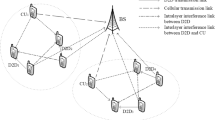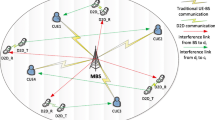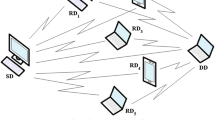Abstract
This paper studies the problem of robust uplink power control in OFDMA-based Device-to-device (D2D) cellular networks composed of cellular and D2D user equipments (UEs). Both cellular UEs and D2D UEs compete with each other to maximize their own utility considering imperfect channel state information (CSI). We formulate a robust Stackelberg game (RSG) based SINR maximization to model this hierarchical competition, where the cellular UEs and D2D UEs are considered to be leaders and followers, respectively. Then, a comprehensive investigation of the RSG is developed with considering various power constraints, various interference constraints and outage probability constraints under a channel uncertainty model. Moreover, we apply the Lagrange dual decomposition method to solve this problem, and an efficient iterative algorithm is proposed to achieve the robust Stackelberg equilibrium (RSE). Global efficiency of the RSE and its complexity are also analysed. Simulation results show that the proposed RSG solution with imperfect CSI can achieve better performance in terms of sum rate for cellular UEs and D2D pairs, sum transmission power, and outage probability by comparing with other existing Stackelberg game solutions.









Similar content being viewed by others
References
Fodor, G., et al. (2012). Design aspects of network assisted device-to-device communications. IEEE Communications Magazine, 50(3), 170–177.
Feng, D. Q., Feng, L. L., & Wu, Y. (2014). Device-to-device communications in cellular networks. IEEE Communications Magazine, 52(4), 49–55.
Lei, L., Zhong, Z., Lin, C., & Shen, X. (2012). Operator controlled device-to-device communications in LTE-advanced networks. IEEE Wireless Communications, 19(3), 96–104.
Phunchongharn, P., Hossain, E., & Kim, D. I. (2013). Resource allocation for device-to-device communications underlaying LTE-advanced networks. IEEE Wireless Communications, 20(4), 91–100.
Fodor, G., Della Penda, D., Belleschi, M., Johanssony, M., & Abrardoz, A. (2013). A comparative study of power control approaches for device to device communications. In Proceedings of the IEEE international conference on communications (ICC) (pp. 6008–6013), Budapest.
Xu, C., Song, L., Han, Z., & Zhao, Q. (2013). Efficiency resource allocation for device-to-device underlay communication systems: A reverse iterative combinatorial auction based approach. IEEE Journal on Selected Areas in Communications, 31(9), 348–358.
Chen, H., Wu, D., & Cai, Y. (2014). Coalition formation game for green resource management in D2D communications. IEEE Communications Letters, 18(8), 1395–1398.
Zhou, Z., Dong, M., Ota, K., & Sato, T. (2014). Energy efficiency and spectral efficiency tradeoff in device-to-device (D2D) communications. IEEE Wireless Communications Letters, 3(5), 485–488.
Wu, D., Wang, J., Hu, R., Cai, Y., & Zhou, L. (2014). Energy-efficient resource sharing for mobile device-to-device multimedia communications. IEEE Transactions Vehicular Technology, 63(5), 2093–2103.
Tang, R., Zhao, J., & Qu, H. (2014). Distributed power control for energy conservation in hybrid cellular network with device-to-device communication. China Communications, 11(3), 27–39.
Song, L., Niyato, D., Zhu, H., & Hossain, E. (2014). Game-theoretic resource allocation methods for device-to-device communication. IEEE Wireless Communications, 21(3), 136–144.
Xu, C., et al. (2012). Resource allocation using a reverse iterative combinatorial auction for device-to-device underlay cellular networks. In Proceedings IEEE global communications conference (pp. 4542–4547). Los Angeles, CA.
Wang F., et al. (2013). Energy-aware resource allocation for device-to-device underlay communication, In Proceedings of the IEEE international conference on communications (ICC), Budapest, Hungary, (pp. 6076–6080).
Xu, C., Song, L., & Han, Z. (2014). Resource management for device-to-device underlay communication (pp. 53–65). Berlin: Springer.
Yin, R., Yu, G., Zhong, C., & Zhang, Z. (2013). Distributed resource allocation for D2D communication underlaying cellular networks. In Proceedings of the IEEE international conference on communications (ICC) (pp.138–143). Budapest, Hungary.
Wang, F., Song, L., & Han, Z. (2013). Joint scheduling and resource allocation for device-to-device underlay communication. In Proceedings of IEEE wireless communications and networking conference (WCNC) (pp. 134–139). Shanghai, China.
Liu, Y., & Feng, S., (2014). Interference pricing for device-to-device communications. In Proceedings of the IEEE international conference on communications (ICC) (pp. 5239–5244). Sydney, NSW.
Xia, C., Xu, S., & Kwak, S. (2014). Resource allocation for device-to-device communication in LTE-A network: A stackelberg game approach. In Proceedings of the IEEE 69th vehicular technology conference (VTC 2014-Spring) (pp. 1–5). Vancouver, BC.
Ye, Q., Al-Shalash, M., Caramanis, C., & Andrews, J. (2015). Distributed resource allocation in device-to-device enhanced cellular networks. IEEE Transactions on Communications, 63(2), 441–454.
Zhu, K., & Hossain, E. (2014). Joint mode selection and spectrum partitioning for device-to-device communication: A dynamic stackelberg game. IEEE Transactions on Wireless Communications, 1(1), 1–15.
Parsaeefard, S., Sharafat, A. R., & Schaar, M. (2014). Robust additively coupled games in the presence of bounded uncertainty in communication networks. IEEE Transactions Vehicular Technology, 63(3), 1436–1452.
Wang, J., Peng, M., Jin, S., & Zhao, C. (2014). A generalized nash equilibrium approach for robust cognitive radio networks via generalized variational inequalities. IEEE Transactions on Wireless Communications, 13(7), 3701–3714.
Han, Q., Yang, B., Wang, X., & Ma, K. (2014). Hierarchical-game-based uplink power control in femtocell networks. IEEE Transactions Vehicular Technology, 63(6), 2819–2835.
Zhu, K., Hossain, E., & Anpalagan, A. (2015). Downlink power control in two-tier cellular OFDMA networks under uncertainties: A robust stackelberg game. IEEE Transactions on Communications, 63(2), 520–525.
Wang, Q., Wang, W., & Jin, S. (2014). Quality-optimized joint source selection and power control for wireless multimedia D2D communication using stackelberg game. IEEE Transactions Vehicular Technology, 1(1), 1–14.
Kandukuri, S., & Boyd, S. (2002). Optimal power control in interference limited fading wireless channels with outage-probability specifications. IEEE Transactions on Wireless Communications, 1(1), 46–55.
Aghassi, M., & Bertsimas, D. (2006). Robust game theory. Mathematical Programming, 207(2), 231–273.
Yang, K., Wu, Y., Huang, J., Wang, X., & Verd, S. (2008). Distributed robust optimization for communication networks. In Proceedings of the IEEE international conference on communications (ICC). Phoenix, AZ.
Horn, R. A., & Johnson, C. R. (1985). Matrix analysis. Cambridge, UK: Cambridge University Press.
Kang, X., Zhang, R., & Motani, M. (2012). Price-based resource allocation for spectrum-sharing femtocell networks: A stackelberg game approach. IEEE Journal on Selected Areas in Communications, 30(3), 538–549.
Xie, R., Yu, F., Ji, H., & Li, Y. (2012). Energy-efficient resource allocation for heterogeneous cognitive radio networks with femtocells. IEEE Transactions on Wireless Communications, 11(11), 3910–3920.
Başarand, T., & Olsder, G. J. (1999). Dynamic non-cooperative game theory. Philadelphia, PA: SIAM.
Facchinei, F., & Kanzow, C. (2010). Generalized nash equilibrium problems. Annals of Operations Research, 175(1), 177–211.
Ardagna, D., Panicucci, B., & Passacantando, M. (2011). A game theoretic formulation of the service provisioning problem in cloud systems. In Proceedings international world wide web conference. Hyderabad, India.
Bertsekas, D., Hager, W., & Mangasarian, O. (1999). Nonlinear programming. MA: Athena Scientific Belmont.
Wang, Q., Wang, W., & Jin, S. (2014). Quality-optimized joint source selection and power control for wireless multimedia D2D communication using stackelberg game. IEEE Transactions Vehicular Technology, 1(1), 1–14.
Acknowledgments
This work was supported by the National Nature Science Foundation of China (61271259 and 61301123), the special fund of Chongqing key laboratory (CSTC), the Program for Changjiang Scholars and Innovative Research Team in University (IRT2129), the Graduate Student Research Innovation Project of Chongqing University of Posts and Telecommunications (Chongqing) (CYS14143).
Author information
Authors and Affiliations
Corresponding author
Appendix: Proof of Theorem 1
Appendix: Proof of Theorem 1
For a market fixed price at the C-UEs, all the D2D pairs aim to maximize their own utility by buying the resource through C-UEs. Thus, we formulate a new objective function for the all D2D pairs, the new utility is the sum utility function of all D2D pairs and can be expressed as follows
Therefore, in order to achieve the actable outcome of the proposed RSG, our concern is guarantying the existence and uniqueness of the RSG when maximize (32). The corresponding Lagrangian function for the D2D pair \(l\) expressed in and the KTT conditions for the D2D pair l is given by
We note that the robust followers’ game shows a jointly convex generalized RSE problem, therefore, the solution of the RSE problem with (2, 16, 18) can is a variational inequality \({\text{VI}}I\left( {{\mathbf{P}},{\mathbf{F}}} \right)\), where \({\mathbf{P}}\) is the set of joint convexity. It is important to determine a vector \(z^{*} \in {\mathbf{P}} \subset {{R}}^{n}\), such that \(\langle {\mathbf{F}}({\mathbf{z}}^{*} ),{\mathbf{z}} - {\mathbf{z}}^{*} \rangle \ge 0\), for all \(z \in {\mathbf{P}}\) and \({\mathbf{F}}({\mathbf{p}}) = - (\nabla_{p} \tilde{U}_{l} ({\mathbf{p}}_{l}^{{}} ))_{l = 1}^{L}\) [34]. Then, the solution of \({\text{VI}}\left( {{\mathbf{P}},{\mathbf{F}}} \right)\) is a variational RSE.
In this paper, we only focus on the power control in D2D cellular networks by assuming the channel assignment has already been done. Then, we can divide the variational inequality \({\text{VI}}\left( {{\mathbf{P}},{\mathbf{F}}} \right)\) into \(N\) subprolems, each subproblem denotes \({\text{VI}}\left( {{\mathbf{P}}_{n} ,{\mathbf{F}}_{n} } \right)\) on the sub-channel \(n\) and they are independent. Therefore, on the sub-channel \(n\), the KKT conditions can be expressed as [33]
Now from the definition of [33], we have
Therefore, the Jacobian of is
Each \({\mathbf{F}}_{n} {\mathbf{J}}_{n}\) is a diagonal matrix and all the diagonal elements are positive. Therefore, \({\mathbf{F}}_{n} {\mathbf{J}}_{n}\) is positive definition on \({\mathbf{P}}_{n}\), and so, \({\mathbf{F}}_{n}\) is strictly monotone. Hence, the global RSG problem admits a unique global variational equilibrium solution [33]. Due to the jointly convex nature of the global RSE problem, the variational equilibrium is the unique global maximizer of (32) [33], which completes the proof in the literature [33].
Rights and permissions
About this article
Cite this article
Yang, H., Xie, X. & Vasilakos, A.V. A Robust Stackelberg Game Based Uplink Power Control for Device-to-Device Communication with Channel Uncertainty and Outage Probability Constraints. Wireless Pers Commun 90, 551–573 (2016). https://doi.org/10.1007/s11277-015-3097-4
Published:
Issue Date:
DOI: https://doi.org/10.1007/s11277-015-3097-4




